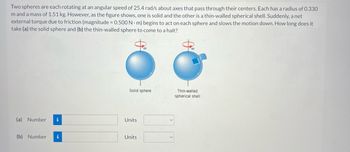
College Physics
11th Edition
ISBN: 9781305952300
Author: Raymond A. Serway, Chris Vuille
Publisher: Cengage Learning
expand_more
expand_more
format_list_bulleted
Concept explainers
Question
Q. 4

Transcribed Image Text:Two spheres are each rotating at an angular speed of 25.4 rad/s about axes that pass through their centers. Each has a radius of 0.330
m and a mass of 1.51 kg. However, as the figure shows, one is solid and the other is a thin-walled spherical shell. Suddenly, a net
external torque due to friction (magnitude = 0.500 Nm) begins to act on each sphere and slows the motion down. How long does it
take (a) the solid sphere and (b) the thin-walled sphere to come to a halt?
(a) Number i
(b) Number i
Solid sphere
Units
Units
Thin-walled
spherical shell
Expert Solution
This question has been solved!
Explore an expertly crafted, step-by-step solution for a thorough understanding of key concepts.
This is a popular solution
Trending nowThis is a popular solution!
Step by stepSolved in 2 steps with 2 images

Knowledge Booster
Learn more about
Need a deep-dive on the concept behind this application? Look no further. Learn more about this topic, physics and related others by exploring similar questions and additional content below.Similar questions
- Wolverine has an arm that is 1[m] long and claws that are 0.5[m] long. He's trying to knock over a wall. His shoulder can exert a torque of 1,500[N-m]. What is the ratio of force on the wall with vs without his claws extended? 1.5[m] point Pivot F /F Adamantium Wall without with claws claws A. 2/3 F Wolverine with В. 3/2 with claws С. 1 1.0[m] Pivot Adamantium D. I don't know but the torque direction is point Wall E. I don't know but the torque direction is Fwithout Wolverine Bare handsarrow_forwardHelparrow_forwardWhat is the force of static friction between the top and bottom blocks assuming the surface is frictionless and the surface between top and bottom blocks has no slipping?arrow_forward
- 400 4 The amount of mass shown on the triple beam riders is – F 401.4 g G 404.5 g H 414.5 g J 444.5 g cm 0 2 3 4 6. 7 8 9 10 11 12 13 14 15 What is the length of the metal rod? A 7.0 cm B 7.5 cm C 8.0 cm D 8.5 cmarrow_forward2.0 kg 4.0 kg d 2.0 m The wooden beam has a mass of 20 kg. What is the distance d that balances the seesaw? 2.0 m 5.0 kgarrow_forwardRachel and Sally are on a seesaw. Rachel, who is older, weighs 80 pounds and sits 4.0 feet from the seesaw’s fulcrum. If Sally weighs 50 pounds, how far from the fulcrum must she sit for the seesaw to balance?arrow_forward
- Problem 6: If cable AB is subject to a tension of 700 N, determine the tension in cables AC and AD and the magnitude of the vertical force F. 3m 6 m- 6 m 3 m B 2 m- 2m 1.5 marrow_forwardJack and Jill want to balance their seesaw. Where should they set the fulcrum? Jack has a mass of 25 kg, Jill has a mass of 15 kg, and the seesaw board has a mass of 20.0 kg.arrow_forward
arrow_back_ios
arrow_forward_ios
Recommended textbooks for you
 College PhysicsPhysicsISBN:9781305952300Author:Raymond A. Serway, Chris VuillePublisher:Cengage Learning
College PhysicsPhysicsISBN:9781305952300Author:Raymond A. Serway, Chris VuillePublisher:Cengage Learning University Physics (14th Edition)PhysicsISBN:9780133969290Author:Hugh D. Young, Roger A. FreedmanPublisher:PEARSON
University Physics (14th Edition)PhysicsISBN:9780133969290Author:Hugh D. Young, Roger A. FreedmanPublisher:PEARSON Introduction To Quantum MechanicsPhysicsISBN:9781107189638Author:Griffiths, David J., Schroeter, Darrell F.Publisher:Cambridge University Press
Introduction To Quantum MechanicsPhysicsISBN:9781107189638Author:Griffiths, David J., Schroeter, Darrell F.Publisher:Cambridge University Press Physics for Scientists and EngineersPhysicsISBN:9781337553278Author:Raymond A. Serway, John W. JewettPublisher:Cengage Learning
Physics for Scientists and EngineersPhysicsISBN:9781337553278Author:Raymond A. Serway, John W. JewettPublisher:Cengage Learning Lecture- Tutorials for Introductory AstronomyPhysicsISBN:9780321820464Author:Edward E. Prather, Tim P. Slater, Jeff P. Adams, Gina BrissendenPublisher:Addison-Wesley
Lecture- Tutorials for Introductory AstronomyPhysicsISBN:9780321820464Author:Edward E. Prather, Tim P. Slater, Jeff P. Adams, Gina BrissendenPublisher:Addison-Wesley College Physics: A Strategic Approach (4th Editio...PhysicsISBN:9780134609034Author:Randall D. Knight (Professor Emeritus), Brian Jones, Stuart FieldPublisher:PEARSON
College Physics: A Strategic Approach (4th Editio...PhysicsISBN:9780134609034Author:Randall D. Knight (Professor Emeritus), Brian Jones, Stuart FieldPublisher:PEARSON

College Physics
Physics
ISBN:9781305952300
Author:Raymond A. Serway, Chris Vuille
Publisher:Cengage Learning

University Physics (14th Edition)
Physics
ISBN:9780133969290
Author:Hugh D. Young, Roger A. Freedman
Publisher:PEARSON

Introduction To Quantum Mechanics
Physics
ISBN:9781107189638
Author:Griffiths, David J., Schroeter, Darrell F.
Publisher:Cambridge University Press

Physics for Scientists and Engineers
Physics
ISBN:9781337553278
Author:Raymond A. Serway, John W. Jewett
Publisher:Cengage Learning

Lecture- Tutorials for Introductory Astronomy
Physics
ISBN:9780321820464
Author:Edward E. Prather, Tim P. Slater, Jeff P. Adams, Gina Brissenden
Publisher:Addison-Wesley

College Physics: A Strategic Approach (4th Editio...
Physics
ISBN:9780134609034
Author:Randall D. Knight (Professor Emeritus), Brian Jones, Stuart Field
Publisher:PEARSON